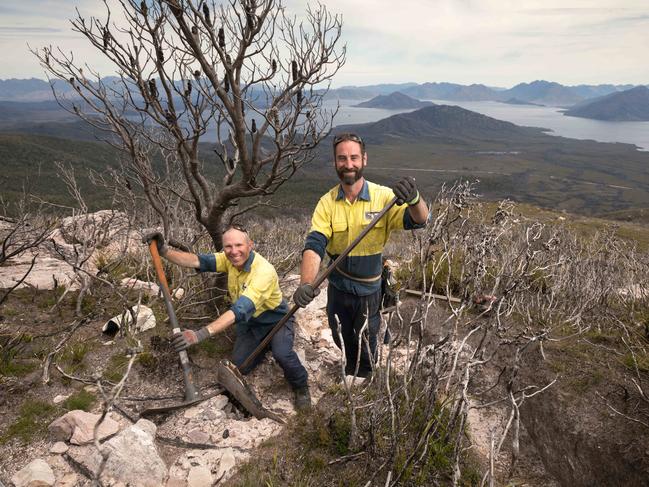Happy trails: ravaged wilderness back on track
Metre by metre, hardy track workers are replacing 117km of Tasmania’s bushwalking trails destroyed by the 2018-19 bushfires.

It’s a challenge almost as large and overwhelming as the surrounding landscapes of towering peaks, mirrored lakes and timeless forests.
But metre by metre, hardy track workers are replacing 117km of Tasmania’s bushwalking trails destroyed by the 2018-19 bushfires that burnt 212,000ha of the state’s national parks.
It’s remote, backbreaking work, with small crews spending nine days on the trot camped in the wilderness, laying new tracks with timber, mesh, stone and gravel.
Conditions are harsh and varied: baking sun and numbing snow — sometimes days apart — at dizzying altitudes, among snakes, biting ants and leeches.
The project is a multimillion-dollar, multi-year endeavour, with the rebuild getting under way only after careful assessment and planning by Tasmania’s Parks and Wildlife Service.
Perched on Mt Eliza, in the state’s vast southwest wilderness, track builders Dan Rowe and Cam Sweeney are relishing the tough but immensely rewarded work.
“I like the creativity of track building. There’s a lot of problem-solving,” explains Dan, 51. “You’re creating a structure in a natural environment, so you’ve got to try to build something that is aesthetically pleasing and in-keeping with your surroundings.
“I think the main thing for us is that by doing what we’re doing, we’re mitigating the impact (of walkers) on the environment. And by doing that, we are getting more people out here, so they can enjoy what we enjoy.”
They work nine days on, five off, when on duty camped below Mt Eliza, typically making a 40-minute or more, almost vertical trek to their work each morning.
As well as a love of the outdoors and isolation and tolerance for extreme weather, track workers must have a flare for design.
While working to specifications, they must adapt to the surface unique to each section of each job as they progress up a mountain or across a buttongrass plain and deal with bogs or water courses. Choppers fly in the materials. The workers then determine how best to use them within a 4m corridor.
While “devastated” to see fragile landscapes so severely fire damaged, the track-building teams — currently deployed on the Mt Anne Track, Lake Judd Track and Huon Track — are the first to see the shoots of recovery.
Dan points to a pink orchid fighting its way through burnt peat. “These orchids used to be all over this hillside; it’s so good to see them coming back,” he says.
Parks project manager Chris West acknowledges that bushwalkers are eager for the tracks to reopen. “It will be worth the wait,” he says. “We are getting it done right for future generations.”




To join the conversation, please log in. Don't have an account? Register
Join the conversation, you are commenting as Logout